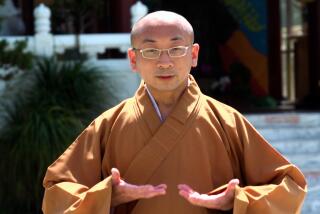Where Is Thy Sting? : THE TIBETAN BOOK OF LIVING AND DYING, by Sogyal Rinpoche ; ( HarperSanFrancisco : $22 ; 413 pp. )
This is a meditation on death.
Do not be afraid.
Do not turn away.
Let your heart be filled with joy.
For death, as Sogyal Rinpoche tells us, is a âmarvelous and amazing dimensionâ that is but a continuation of our consciousness and an affirmation of the unending nature of mind. To many Westerners, imbued with âdread deathâ since the time of Homer, the idea of embracing this most terrifying of experiences seems strange indeed, particularly during the holidays.
But as Rinpoche, a renowned Tibetan Buddhist meditation master, makes clear, to die well is no less an accomplishment than to live well--and, as he notes again and again, both life and death are simply in the mind.
âWe spend millions of dollars every minute on training people to kill and destroy, and on bombs and planes and missiles,â he argues, âbut we spend hardly anything, in comparison, on teaching human beings the nature of life and death, and helping them, when they come to die, to face and understand what is happening to them.â
As a Tibetan, Rinpoche is reflecting the traditions of his ancient culture, where it is death, not birth or marriage, that is most important. Amid the basso profundo chanting of scores of lamas, Tibetan families sit by their dying loved ones for weeks at a time. After the death, they may go deeply into debt to ensure that the deceased has the benefit of proper ceremonies, which extend up to 49 days--a period when the personâs consciousness is believed to be preparing for rebirth.
In its acceptance of the seamlessness of life and death, the Tibetan tradition turns upside down the beginning-and-end nature of what most Westerners, with their tendency to denial, believe.
Thus, as food for a âquiet revolution in the whole way we look at death . . . and so the whole way we look at life,â Rinpocheâs teachings have much to offer, even if you are already familiar with Tibetan Buddhism. His down-to-earth tone, peppered with songs and poetry from Buddhist sages, takes away much of the intense fear of death and makes it seem like an old friend. Death, he tells us, is the door to our inherent nature and an opportunity for enlightenment.
This is not to say Rinpoche is in the least morbid. He takes life seriously--how we live now will surely affect how we are after death and in the next life. Above all, he reminds us of the central pillar of Buddhism: that everything is impermanent, and that letting go of desire, anger and ignorance leads to true freedom. He quotes the Buddha:
This existence of ours is as transient as autumn clouds.
To watch the birth and death of beings is like looking at the movements of a dance.
A lifetime is like a flash of lightning in the sky,
Rushing by, like a torrent down a steep mountain.
How do you navigate this torrent? With a guide, of course. And that is the heart of this book--a stage-by-stage guide through the four bardos , the continuously linked realities that Tibetan Buddhists believe comprise past, present and future.
Some of that guidance is sure to be difficult for Westerners to grasp, as in the concept of âmerging with the wisdom mind.â But with consummate skill, Rinpoche accompanies us through it all, from the basics of meditation to the concept of karma.
For the dying person, he carefully describes the journey through the moment of death and into the â bardo of becoming,â where we relive all experience of our past life and eventually make a karmic connection with our future parents.
Rinpoche also delves into the spiritual phenomena that have distinguished Tibet as a center of faith, even after the brutal Chinese invasion four decades ago. For example, we have no trouble believing it when he recounts how one lama passed away but was brought back to life briefly by his spiritual master, the great Jamyang Khyentse.
Still, when he addresses us outside the realm of pure philosophy he is probably easiest for most Westerners to comprehend. He counsels that unconditional love is the greatest gift of charity to the dying. A fervent supporter of the hospice movement, he writes passionately of lessons in giving, hope and forgiveness.
More to Read
Sign up for our Book Club newsletter
Get the latest news, events and more from the Los Angeles Times Book Club, and help us get L.A. reading and talking.
You may occasionally receive promotional content from the Los Angeles Times.







